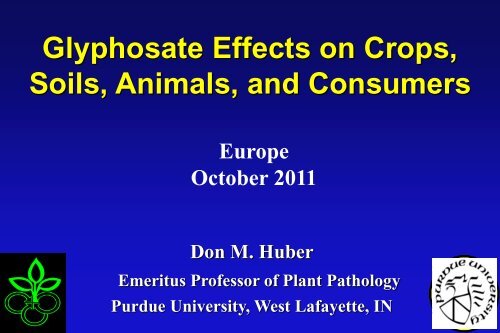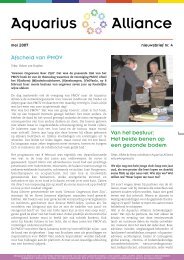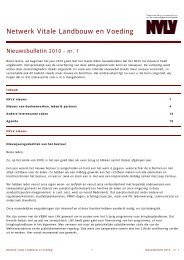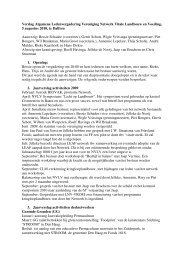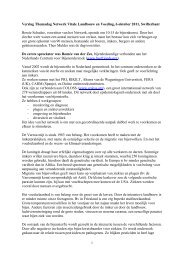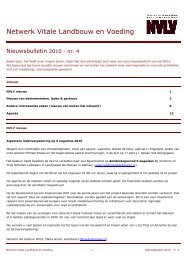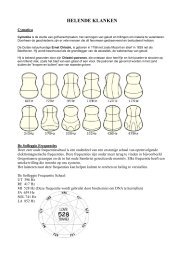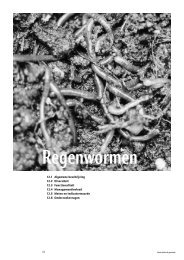Glyphosate Effects on Crops, Soils, Animals, and Consumers
Glyphosate Effects on Crops, Soils, Animals, and Consumers
Glyphosate Effects on Crops, Soils, Animals, and Consumers
You also want an ePaper? Increase the reach of your titles
YUMPU automatically turns print PDFs into web optimized ePapers that Google loves.
<str<strong>on</strong>g>Glyphosate</str<strong>on</strong>g> <str<strong>on</strong>g>Effects</str<strong>on</strong>g> <strong>on</strong> <strong>Crops</strong>,<br />
<strong>Soils</strong>, <strong>Animals</strong>, <strong>and</strong> C<strong>on</strong>sumers<br />
Europe<br />
October 2011<br />
D<strong>on</strong> M. Huber<br />
Emeritus Professor of Plant Pathology<br />
Purdue University, West Lafayette, IN
The Importance of Reducing Stresses<br />
Genetic<br />
Potential<br />
-<br />
Nutriti<strong>on</strong><br />
Physiology<br />
Management<br />
Envir<strong>on</strong>ment<br />
Diseases<br />
Pests<br />
=<br />
Harvest<br />
Potential - Stresses = Yield<br />
There is no free lunch!
Quality traits Water<br />
Genotypes of plants<br />
Temperature<br />
Heat<br />
Cold<br />
CO2<br />
O2<br />
Ca<br />
H<br />
Mg<br />
N<br />
P<br />
Light (cycles,, intensity)<br />
K<br />
Mn<br />
Insects<br />
Bacteria<br />
Virus<br />
Soil physics<br />
Fungi<br />
Fe<br />
Na<br />
Al<br />
Cu<br />
Mo<br />
Zn<br />
Pesticides<br />
Organic matter<br />
Cl Ni<br />
Nematodes Pollutants There are a large number of interc<strong>on</strong>nected<br />
plant properties <strong>and</strong> resp<strong>on</strong>ses to physical <strong>and</strong> biological envir<strong>on</strong>mental<br />
B<br />
Si
Nutrients are:<br />
Comp<strong>on</strong>ents of plant parts as well as<br />
Activators,<br />
Inhibitors,<br />
<strong>and</strong> Regulators<br />
of Physiological Processes<br />
Many herbicides <strong>and</strong> pesticides are chelators
Interacting Factors Determining<br />
Nutrient Availability <strong>and</strong> Disease Severity<br />
Vigor, Stage of Growth, Root Exudates<br />
Resistance<br />
PLANT<br />
Susceptibility<br />
PATHOGEN<br />
Populati<strong>on</strong><br />
Virulence<br />
Activity<br />
TIME<br />
BIOTIC ENVIRONMENT<br />
Antag<strong>on</strong>ists, Synergists<br />
Oxidizers, Reducers<br />
Competitors, Mineralizers<br />
[Cu, Fe, K, Mn, N, S, Zn]<br />
ABIOTIC<br />
ENVIRONMENT<br />
Nutrients<br />
Moisture<br />
Temperature<br />
pH (redox potential)<br />
Density, gases<br />
Ag Chemicals
Foliar applicati<strong>on</strong> of glyphosate<br />
Moves<br />
throughout the plant<br />
Intensifies stress<br />
<str<strong>on</strong>g>Glyphosate</str<strong>on</strong>g> accumulates in soil<br />
(fast sorpti<strong>on</strong>; slow degradati<strong>on</strong>)<br />
Desorbed by phosphorus<br />
<str<strong>on</strong>g>Glyphosate</str<strong>on</strong>g> is toxic to:<br />
(Beneficial soil organisms)<br />
N-fixing microbes<br />
Bacterial shikimate pathway<br />
Mycorrhizae<br />
Biological c<strong>on</strong>trol organisms<br />
Earthworms<br />
PGPR organisms<br />
<str<strong>on</strong>g>Glyphosate</str<strong>on</strong>g> accumulates in<br />
Plant tissues (shoot,<br />
reproductive, <strong>and</strong> roots)<br />
<str<strong>on</strong>g>Glyphosate</str<strong>on</strong>g> moves<br />
into roots <strong>and</strong> is released<br />
into soil<br />
1. Makes the plant susceptible to<br />
diseases<br />
2. Increases soil-borne diseases<br />
3. Decreases Nutrient availability<br />
Schematic of glyphosate interacti<strong>on</strong>s in soil
Herbicide acti<strong>on</strong> is by soil-borne fungal pathogens<br />
<str<strong>on</strong>g>Glyphosate</str<strong>on</strong>g> Increases Disease Susceptibility<br />
A<br />
B<br />
C<br />
<str<strong>on</strong>g>Glyphosate</str<strong>on</strong>g> <str<strong>on</strong>g>Glyphosate</str<strong>on</strong>g> No glyphosate Effect of glyphosate <strong>on</strong> susceptibility<br />
Sterile soil Field soil C<strong>on</strong>trol to anthracnose. A) hypersensitive<br />
resp<strong>on</strong>se; B) n<strong>on</strong>-limited resp<strong>on</strong>se<br />
after glyphosate is applied.<br />
After Rahe <strong>and</strong> Johal, 1988; 1990; See also Johal <strong>and</strong> Huber, 1999; Schafer et al, 2009.<br />
A<br />
B
C<strong>on</strong>trol Inoculated Inoculated<br />
+ glyphosate<br />
N<strong>on</strong>-glyphosate<br />
N<strong>on</strong>-GMO<br />
GMO+glyphosate<br />
<str<strong>on</strong>g>Glyphosate</str<strong>on</strong>g><br />
No glyphosate<br />
N<strong>on</strong>-glyphosate<br />
<str<strong>on</strong>g>Glyphosate</str<strong>on</strong>g>
Factors Predisposing to Fusarium Head Scab<br />
(Fusarium spp.; Gibberella zeae)<br />
Envir<strong>on</strong>ment was the most important<br />
factor in FHB development in eastern<br />
Saskatchewan, from 1999 to 2002<br />
Applicati<strong>on</strong> of glyphosate formulati<strong>on</strong>s<br />
was the most important agr<strong>on</strong>omic<br />
factor associated with higher FHB<br />
levels in spring wheat<br />
Positive associati<strong>on</strong> of glyphosate with<br />
FHB was not affected by envir<strong>on</strong>mental<br />
c<strong>on</strong>diti<strong>on</strong>s as much as that of other<br />
agr<strong>on</strong>omic factors…<br />
(Fern<strong>and</strong>ez et al. 2005, Crop Sci. 45: 1908-1916)<br />
(Fern<strong>and</strong>ez et al., 2007, Crop Sci. 47:1574-1584)<br />
Number of<br />
glyphosate<br />
applicati<strong>on</strong>s<br />
the previous<br />
three years<br />
%<br />
Increase<br />
in head<br />
scab<br />
_______________________________<br />
N<strong>on</strong>e 00<br />
1 to 2 152 ***<br />
3 to 6 295 ***<br />
_______________________________
What‟s Special About <str<strong>on</strong>g>Glyphosate</str<strong>on</strong>g> Tolerance?<br />
(Roundup Ready® Genes)<br />
• The technology inserts an alternative EPSPS enzyme<br />
that is not blocked by glyphosate in mature tissue<br />
• There is nothing in the RR plant that operates <strong>on</strong><br />
the glyphosate applied to the plant!<br />
<str<strong>on</strong>g>Glyphosate</str<strong>on</strong>g> chelati<strong>on</strong> is not selective it immobilizes nutrients<br />
Ca, Co, Cu, Fe, K, Mg, Mn, Ni, Zn<br />
Reduces nutrient uptake<br />
• Can cause a“Yield Drag”<br />
• It is there for the life of<br />
the plant<br />
[Greatly exp<strong>and</strong>ed usage of glyphosate]<br />
% uptake<br />
100<br />
75<br />
50<br />
25<br />
Indiana Kansas Michigan Brazil Indiana Brazil<br />
Normal<br />
RR<br />
0<br />
Soybeans for manganese<br />
Corn/Mn Soybeans/Zn
Reduced Nutrient Efficiency of Isogenic<br />
RR Soybeans (After Zobiole et al, 2008, 2009)<br />
Tissue: Mn Zn<br />
Isoline % %<br />
Normal 100 100<br />
Roundup Ready© 83 53<br />
RR + glyphosate 76 45<br />
Copper, ir<strong>on</strong>, <strong>and</strong> other essential nutrients<br />
Were also lower in the RR isoline <strong>and</strong> reduced<br />
further by glyphosate!
Effect of <str<strong>on</strong>g>Glyphosate</str<strong>on</strong>g> <strong>on</strong> Lignin, AA, Water Use Efficiency,<br />
<strong>and</strong> Photosynthesis of „<str<strong>on</strong>g>Glyphosate</str<strong>on</strong>g>-Resistant‟ Soybeans<br />
Lignin<br />
(g/plant)<br />
Full rate at <strong>on</strong>e time<br />
0.6<br />
0.5<br />
Sequential half rate<br />
0.4<br />
0.3<br />
0.2<br />
0.1<br />
0.0 0 450 675 900 1350 1800<br />
<str<strong>on</strong>g>Glyphosate</str<strong>on</strong>g> (g a.e./ha)<br />
Amino Acids (g/plant)<br />
2500<br />
Full rate at <strong>on</strong>e time<br />
2000<br />
Sequential half rate<br />
1500<br />
1000<br />
500<br />
0.0<br />
0 450 675 900 1350 1800<br />
<str<strong>on</strong>g>Glyphosate</str<strong>on</strong>g> (g a.e./ha)<br />
After Zobiole, 2009<br />
umol CO 2 m -2 s -1<br />
12<br />
10<br />
8<br />
6<br />
4<br />
2<br />
0<br />
13 DAT<br />
36 DAT<br />
0 600 1200 1800 2400<br />
<str<strong>on</strong>g>Glyphosate</str<strong>on</strong>g> (g a.e./ha)<br />
WUE (ml water/g dry mass)<br />
600<br />
550<br />
500<br />
450<br />
400<br />
350<br />
300<br />
250 0 450 675 900 1350 1800<br />
<str<strong>on</strong>g>Glyphosate</str<strong>on</strong>g> (g a.e./ha)
Microbiocidal Activity<br />
of <str<strong>on</strong>g>Glyphosate</str<strong>on</strong>g><br />
Fusarium % change<br />
500<br />
400<br />
300<br />
200<br />
100<br />
% of c<strong>on</strong>trol<br />
100<br />
80<br />
60<br />
40<br />
20<br />
<str<strong>on</strong>g>Glyphosate</str<strong>on</strong>g> rate<br />
C<strong>on</strong>trol<br />
600 g ae/ha<br />
1200 g ae/ha<br />
2400 g ae/ha<br />
0<br />
Fusarium<br />
root col<strong>on</strong>izati<strong>on</strong><br />
0<br />
Pseudom<strong>on</strong>ads Mn reducers IAA producers<br />
After Zobiole et al., 2010<br />
Kremer, 2010
Nodule mass (mg/plant)<br />
Effect of the RR Gene & Herbicide <strong>on</strong> Root Nodule Mass<br />
After Kremer & Means, 2009<br />
4000<br />
3500<br />
3000<br />
C<strong>on</strong>trol<br />
<str<strong>on</strong>g>Glyphosate</str<strong>on</strong>g><br />
Soybean nodulati<strong>on</strong> at R1, 2010<br />
2500<br />
2000<br />
1500<br />
1000<br />
500<br />
0<br />
Williams 82<br />
DKB 38-52 [RR]<br />
Soybean variety<br />
<str<strong>on</strong>g>Glyphosate</str<strong>on</strong>g><br />
C<strong>on</strong>trol<br />
Photo by R. Kremer
Effect of <str<strong>on</strong>g>Glyphosate</str<strong>on</strong>g> Drift* <strong>on</strong> Soybean Leaf<br />
<strong>and</strong> Seed Ir<strong>on</strong> & Ferric Reductase Activity<br />
% reducti<strong>on</strong><br />
100<br />
80<br />
60<br />
C<strong>on</strong>trol<br />
GS variety 1<br />
GS variety 2<br />
GR variety<br />
40<br />
20<br />
0<br />
Leaf Fe c<strong>on</strong>tent Seed Fe c<strong>on</strong>tent Ferric reductase activity<br />
*Drift rate = 12.5 % of herbicide rate = 56 g/a<br />
After Bellaloui et al, 2009
% Mineral Reducti<strong>on</strong> in Roundup Ready®<br />
Soybeans Treated with <str<strong>on</strong>g>Glyphosate</str<strong>on</strong>g><br />
Plant tissue Ca Mg Fe Mn Zn Cu<br />
Young leaves 40 28 7 29 NS NS<br />
Mature leaves 30 34 18 48 30 27<br />
Mature grain 26 13 49 45<br />
Reduced:<br />
Yield 26%<br />
Biomass 24% After Cakmak et al, 2009
Anthranilate<br />
IAA<br />
Indolacetic<br />
acid<br />
M<strong>on</strong>ocot:<br />
Salycil+>SAR<br />
PR2 PR5<br />
= susceptible<br />
Jasm<strong>on</strong>ique<br />
PR1 PR3<br />
PR5 PR9<br />
= résistant<br />
M n<br />
Glycolysis<br />
PEP pyruvate<br />
M n<br />
Chorismate<br />
Tryptophan<br />
IAA<br />
degradati<strong>on</strong><br />
Phytoalexins:<br />
Phenylpropanoids<br />
Salicylate & SAR<br />
PR Proteins<br />
Pentose cycle<br />
Erythrose-4-PO4<br />
M n<br />
Shikimate<br />
Prephrenic<br />
Phenylalanine<br />
M n<br />
Cinnamic<br />
Coumaric<br />
Coumaryl OH<br />
M<strong>on</strong>ocot M n<br />
L I G N I N<br />
H 2 O 2<br />
Tyrosine<br />
Caffeic<br />
Ferulic<br />
C<strong>on</strong>iferyl OH<br />
Gymnosperms<br />
L I G N I N<br />
M n<br />
CELL WALLS<br />
M n<br />
whole C o pathway B *<br />
Adapted from Graham & Webb 1991<br />
Cyanogenic<br />
glycosides<br />
Sinapyl OH<br />
M n<br />
Quin<strong>on</strong>es<br />
Dicots<br />
* probable<br />
H 2 O 2<br />
M n<br />
F e<br />
One missing<br />
micr<strong>on</strong>utrient C u S i =<br />
damage to a<br />
Lignin
L<strong>on</strong>g-term Effect of <str<strong>on</strong>g>Glyphosate</str<strong>on</strong>g><br />
after Roemheld et al., 2009
Preemergence<br />
glyphosate<br />
No<br />
glyphosate<br />
Preemergence<br />
glyphosate<br />
No<br />
glyphosate<br />
Preemergence<br />
<str<strong>on</strong>g>Glyphosate</str<strong>on</strong>g><br />
No glyphosate<br />
Poor<br />
Bulking<br />
5# 5 oz 9# 13 oz
Failure to „Bulk‟ of Russet Potatoes<br />
<str<strong>on</strong>g>Glyphosate</str<strong>on</strong>g> How No. % Potatoes<br />
frequency applied growers over 10 oz<br />
N<strong>on</strong>e in the<br />
previous 2 yrs N<strong>on</strong>e 5 35.3<br />
1-2 in the<br />
previous 2 yrs Burn down 17 20.2<br />
Preceding year RR crop 5 5.4<br />
Parent plant with glyphosate drift<br />
Daughter seed pieces
Food <strong>and</strong> Feed Safety C<strong>on</strong>cerns<br />
‣ Increased levels of mycotoxins<br />
- Fusarium toxins (DON, NIV, ZEA)<br />
- Aflatoxins<br />
‣ Gene flow<br />
- Weeds<br />
- Soil microbes<br />
- Intestinal microbes<br />
‣Nutrient deficiency<br />
- Cu, Fe, Mg, Mn, Zn<br />
‣ Direct toxicity of residual glyphosate<br />
- Infertility - endocrine system<br />
- Birth defects, teratogenicity<br />
- Cell death - Disease resistance<br />
‣ Allergenic reacti<strong>on</strong>s to foreign proteins<br />
Aris & Leblanc, 2011<br />
Benachour et al, 2007<br />
Carmen, et al., 2011<br />
Fern<strong>and</strong>ez, et al., 2009<br />
Gasnier, et al., 2009<br />
Heiman, 2010<br />
Matzk et al, 1996<br />
Seralini et al., 2010, 2011<br />
Smith, 2010<br />
Walsh, et al., 2000<br />
Watts, 2009
% Reducti<strong>on</strong> in Alfalfa Nutrients by <str<strong>on</strong>g>Glyphosate</str<strong>on</strong>g>*<br />
Nutrient<br />
Nitrogen 13 %<br />
Phosphorus 15 %<br />
Potassium 46 %<br />
Calcium 17 %<br />
Magnesium 26 %<br />
Sulfur 52 %<br />
Bor<strong>on</strong> 18 %<br />
Copper 20 %<br />
Ir<strong>on</strong> 49 %<br />
Manganese 31 %<br />
Zinc 18 %<br />
% reducti<strong>on</strong> compared with N<strong>on</strong>-RR<br />
*Third year, sec<strong>on</strong>d cutting analysis; <str<strong>on</strong>g>Glyphosate</str<strong>on</strong>g> applied <strong>on</strong>e time in the previous year
Stillborne Calf from Manganese Deficiency
U.S. Cattlemen‟s Associati<strong>on</strong> Statement to C<strong>on</strong>gress<br />
“Cattle ranchers are facing some puzzling - <strong>and</strong>, at times,<br />
ec<strong>on</strong>omically devastating problems with pregnant cows <strong>and</strong> calves. At<br />
some facilities, high numbers of fetuses are aborting for no apparent<br />
reas<strong>on</strong>. Other farmers successfully raise what look to be normal young<br />
cattle, <strong>on</strong>ly to learn when the animals are butchered that their carcasses<br />
appear old <strong>and</strong>, therefore, less valuable.”<br />
“The sporadic problem is so bad both in the United States <strong>and</strong> abroad<br />
that in some herds around 40-50 percent of pregnancies are being lost.”<br />
“Many pesticides <strong>and</strong> industrial pollutants also possess a horm<strong>on</strong>al alter<br />
ego.”<br />
“The viability of this important industry is threatened.”<br />
Source: Testim<strong>on</strong>y of the Ranchers-Cattlemen Acti<strong>on</strong> Legal Fund, United Stockgrowers<br />
of America, to the Senate Agriculture Committee July 24, 2002.
Feed Source Effect <strong>on</strong> Stomach Liner Color, Carmen et al, 2010<br />
N<strong>on</strong>-GMO<br />
GMO
Effect of the GM “Gene” Proteins in<br />
Corn/Soybeans <strong>on</strong> Pig Stomachs<br />
2011<br />
N<strong>on</strong>-GMO Feed<br />
GMO Feed<br />
Normal color<br />
Inflamed, irritated
Percentage of acres planted<br />
Inflammatory Bowel Disease, USA<br />
Cases/100,000 populati<strong>on</strong><br />
90<br />
GM Soy<br />
80<br />
70<br />
60<br />
50<br />
40<br />
20<br />
GM Corn<br />
Hospital discharges<br />
Ambulatory care visits<br />
10<br />
0<br />
1992 1994 1996 1998 2000 2002 2004<br />
Year
And the Mice Prefer……<br />
GMO<br />
Corn<br />
N<strong>on</strong>-GMO<br />
Corn<br />
Photos: Gilbert Hostetler
Direct Toxicity of <str<strong>on</strong>g>Glyphosate</str<strong>on</strong>g><br />
Rate (ppm) System affected Reference<br />
0.5 Human cell endocrine disrupti<strong>on</strong> Toxicology 262:184-196, 2009<br />
0.5 Anti-<strong>and</strong>rogenic Gasner et al, 2009<br />
1.0 Disrupts aramatase enzymes Gasnier et al, 2009<br />
1-10 Inhibits LDH, AST, ALF enzymes Malatesta et al, 2005<br />
1-10 Damages liver, mitoch<strong>on</strong>dria, nuclei Malatesta et al, 2005<br />
2.0 Anti-Oestrogenic Gasnier et al, 2009<br />
5.0 DNA damage Toxicology 262:184-196, 2009<br />
5.0 Human placental, umbilical, embryo Chem.Res.Toxicol. J. 22:2009<br />
10 Cytotoxic Toxicology 262:184-196, 2009<br />
10 Multiple cell damage Seralini et al, 2009<br />
10 Total cell death Chem.Res.Toxicol. J. 22:2009<br />
All Systemic throughout body And<strong>on</strong> et al, 2009<br />
1-10 Suppress mitoch<strong>on</strong>drial respirati<strong>on</strong> Peixoto et al, 2005<br />
Parkins<strong>on</strong>‟s El Demerdash et al, 2001<br />
POEA, AMPA even more toxic Seralini et al, 2009
Late term<br />
‘Sp<strong>on</strong>taneous<br />
Aborti<strong>on</strong>’<br />
(Miscarriage)
„Fungus-like‟ Growth<br />
(transmissi<strong>on</strong> EM)<br />
Size of organism compared<br />
with alfa-Streptococcus<br />
38,250 X magnificati<strong>on</strong><br />
Size relative to gram + bacterium
Occurrence<br />
•Verified in IA, IL, KY, MI, NE, ND, SD, WI<br />
• Sources: „Envir<strong>on</strong>mental‟<br />
Soybean meal<br />
Silage<br />
Corn grain <strong>and</strong> silage<br />
SDS Soybean plants<br />
Manure<br />
Soil<br />
Animal tissue<br />
Fusarium solani fsp glycines mycelium<br />
Placental tissue<br />
Amniotic fluid<br />
Semen<br />
Stomach c<strong>on</strong>tents<br />
Eggs<br />
Milk
Potential Interacti<strong>on</strong>s of „new entity‟ with <str<strong>on</strong>g>Glyphosate</str<strong>on</strong>g><br />
• <str<strong>on</strong>g>Glyphosate</str<strong>on</strong>g> affects plants (predisposes):<br />
Inhibits plant defenses<br />
Reduces nutrient c<strong>on</strong>tent <strong>and</strong> efficiency [chemical <strong>and</strong> RR gene(s)]<br />
Increases root col<strong>on</strong>izati<strong>on</strong><br />
Increases membrane permeability<br />
Surfactant affect for penetrati<strong>on</strong> of natural openings <strong>and</strong> wounds<br />
• <str<strong>on</strong>g>Glyphosate</str<strong>on</strong>g> affects animals (predisposes):<br />
Inhibits aramatose system – endocrine horm<strong>on</strong>e system<br />
Toxic to liver, placental, testicular, <strong>and</strong> kidney cells<br />
Reduced defense - liver functi<strong>on</strong> [from lower Mn, etc. in feed]<br />
• <str<strong>on</strong>g>Glyphosate</str<strong>on</strong>g> affects pathogens:<br />
Stimulates growth <strong>and</strong> virulence (direct/indirect)<br />
Favors synergism, infecti<strong>on</strong> (as a carrier)<br />
Increases movement into plant tissues (water film for plant infecti<strong>on</strong>)<br />
• <str<strong>on</strong>g>Glyphosate</str<strong>on</strong>g> affects the envir<strong>on</strong>ment:<br />
Toxic to soil microbes that c<strong>on</strong>strain plant pathogens<br />
Micr<strong>on</strong>utrient availability reduced
Failure to H<strong>on</strong>or<br />
* Scientific Precauti<strong>on</strong>ary Principle<br />
1. Margin of safety to prevent damage<br />
2. Anticipati<strong>on</strong> of unknowns<br />
3. Initiate as a “pilot project”<br />
* Not “Substantially Equivalent”- Significant deviati<strong>on</strong> in:<br />
1. Expressi<strong>on</strong> of „end products‟ (new/tissues in)<br />
2. More like virus infecti<strong>on</strong> than sexual transfer<br />
3. Functi<strong>on</strong>al <strong>and</strong> regulatory c<strong>on</strong>trols absent<br />
4. Greatly extended exposure<br />
5. Producti<strong>on</strong>, quality, safety & toxicity differ<br />
After Brown, 2000
Potential Far-Reaching Impact of <str<strong>on</strong>g>Glyphosate</str<strong>on</strong>g><br />
Human<br />
Mineral malnourished,<br />
Allergies, Fertility, Disease<br />
MYCOTOXINS<br />
Alzheimer‟s, gout, diabetes, viruses, Parkins<strong>on</strong>;s, etc.<br />
Vegetables, fruits, grains<br />
Lower nutrient minerals<br />
(Cu, Fe, Mg, Mn, Zn)<br />
Carriers for epiphytes<br />
(E. coli, etc. )<br />
(Changed epiphytic flora)<br />
<str<strong>on</strong>g>Glyphosate</str<strong>on</strong>g><br />
Mn<br />
<str<strong>on</strong>g>Glyphosate</str<strong>on</strong>g><br />
(Chelati<strong>on</strong>)<br />
Plants, feed<br />
Lower nutrient minerals<br />
(Cu, Fe, Mn, Zn)<br />
Disease predispositi<strong>on</strong><br />
(Scab, take-all, CVC)<br />
Mycotoxins, glyphosate<br />
Envir<strong>on</strong>ment<br />
Biological imbalance<br />
N fixati<strong>on</strong>, Mn availability<br />
Potassium immobilizati<strong>on</strong><br />
Biological c<strong>on</strong>trols<br />
GLYPHOSATE ACCUMULATION<br />
<strong>Animals</strong><br />
Mineral malnourished<br />
Slow growth, Allergies, Disease<br />
MYCOTOXINS<br />
Scours, death, BSE, wasting, predispositi<strong>on</strong>
Failed Promises – Touted Benefits<br />
Higher yields<br />
Fewer pesticides<br />
Less post-harvest loss<br />
Improved N-fixati<strong>on</strong><br />
Drought <strong>and</strong> salt tolerance<br />
Increased photosynthesis<br />
Greater root growth & functi<strong>on</strong><br />
Disease resistance<br />
Lower risks (ec<strong>on</strong>omic)<br />
Lower cost<br />
Greater safety<br />
Simpler management – resistant weeds & pests<br />
BETRAYAL OF THE PUBLIC TRUST
Make Sure You Provide the Food!


